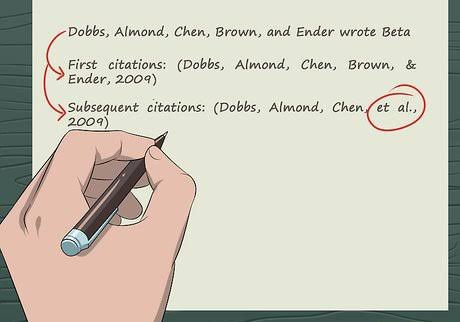‘Et al.’ is a Latin phrase meaning “and others.” It is commonly used to shorten the list of authors in a research paper when the list is too long. It is an abbreviation for the phrase “et alia” which means “and others”. This abbreviation is often used in academic writing and is an important part of the research process. In this article, we will discuss when to use ‘et al.’ and how you can use it correctly in your research paper. You will learn the correct format to use when citing multiple authors, as well
as the rules and conventions of using ‘et al.’ correctly. With this knowledge, you will be able to confidently use ‘et al.’ in your research paper.
When to Use ‘et al.’
‘Et al.’ stands for ‘et al’, which is Latin for ‘and others’. You can use et al. when you want to refer to a group of people or authors that begins with a vowel or several vowels. You can also use it when you want to list only two authors, but the first one starts with a vowel. It’s important to use et al. if you can’t use ‘and’ because the people you are citing have names that begin with vowels. If you use ‘and’, you’ll list these people as if they were the only ones who wrote on the topic. Using et al. allows you to acknowledge others whose names are not the same as the first author. For example, in ‘The Nature of the Particular’, Et Al. refers to the authors, David W. Clark and Kathryn R. Wilkinson. In this paper, these two authors are exploring the nature of the particular as it relates to speech, language, and meaning. The use of ‘et al.’ also indicates that although Clark and Wilkinson were the original authors of this paper, there could be others who contributed to it as well.
How to Use ‘et al.’ Correctly
The correct way to use et al. in your writing is to put two periods after the abbreviation, followed by the word ‘and’, followed by the word ‘others’. All lowercase letters and no italics or quotation marks are used for et al. Since the phrase ‘and others’ is a part of the original title, you don’t need to italicize or put ‘(’ and ‘)’ around it. However, if you’re citing a source that uses et al. and you want to refer to the authors, you can use ‘Et Al.’ with a capital ‘A’ and capital ‘L’. This is the proper way to cite this abbreviation in a citation.
‘Et al.’ in Citations
To cite a source that uses et al., you need to identify the first author, followed by “et al.”. Next, you need to list all the authors in the order in which they were referenced in the source, followed by “and others”. Then you need to add the title of the source, followed by the publication date in parentheses. For example, if you’re citing the source ‘The Nature of the Particular’, you would reference it like this: David W. Clark and Kathryn R. Wilkinson. “The Nature of the Particular.” Philosophy and Rhetoric, vol. 48, no. 4, 2015, pp. 477–493.
Formatting ‘et al.’ in Research Papers
If the paper you’re writing has two authors, you don’t need to use et al. Instead, you can just write the authors’ names in the order that they were listed in the source. If you’re citing a source that has three or more authors, you need to use et al. You can also use et al. if your source has two authors, but the first author’s name begins with a vowel. When using et al. in your paper, you need to pay special attention to the formatting. You need to be consistent with how you format the name of the source and the name of the authors throughout your paper. There are many ways to format et al. in your paper. The most common way is to put the name of the source in italics and put the name of the authors in parentheses.
Avoiding Common Mistakes with ‘et al.’
There are a few common mistakes that people make when using et al. The main mistake is not adding the ‘and others’ part of the abbreviation. If you don’t add this part, you end up listing the authors as the only ones who contributed to the source. Another common mistake is adding the abbreviation with a lowercase ‘a’. When you do this, you’re writing ‘et alii’, which is incorrect. The correct way to write the abbreviation ‘et alii’ is with a capital ‘A’. It’s also important to make sure you don’t use ‘et al.’ with three or more authors in one source. Although it’s common to use the abbreviations ‘et al.’ and ‘and others’ interchangeably, these phrases are used differently.
Conclusion
Although it’s a commonly used abbreviation, et al. is one of the most misunderstood abbreviations in academia. Knowing how to properly use et al. in your research papers will help you make your writing more efficient. Using et al. also lets your readers know that you acknowledge other voices. With this guide, you’ll be able to confidently use et al. in your research papers without worrying about making mistakes.




